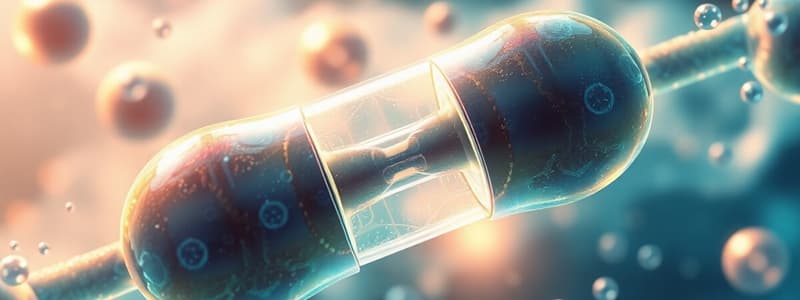Podcast
Questions and Answers
What is the primary focus of the experimental aspect of pharmacokinetics?
What is the primary focus of the experimental aspect of pharmacokinetics?
- Determining the relationship between drug concentration and response
- Development of pharmacokinetic models
- Adjusting dosing regimens for subtherapeutic responses
- Biologic sampling techniques and analytical methods (correct)
What do pharmacokinetic models predict?
What do pharmacokinetic models predict?
- Patient responses to therapy
- Drug interactions and side effects
- Optimal drug storage conditions
- Drug disposition after administration (correct)
Why are statistical methods crucial in pharmacokinetic studies?
Why are statistical methods crucial in pharmacokinetic studies?
- To create drug formulations
- To assess the efficacy of clinical trials
- For parameter estimation and data interpretation (correct)
- To determine drug side effects
What phenomenon may result from intra- and interindividual variations in drug disposition?
What phenomenon may result from intra- and interindividual variations in drug disposition?
Clinical pharmacokinetics is best described as which of the following?
Clinical pharmacokinetics is best described as which of the following?
Which factors can potentially influence pharmacokinetic differences in drug therapy?
Which factors can potentially influence pharmacokinetic differences in drug therapy?
Population pharmacokinetics specifically studies which aspect of drug disposition?
Population pharmacokinetics specifically studies which aspect of drug disposition?
What does pharmacodynamics primarily examine?
What does pharmacodynamics primarily examine?
Which factor does biopharmaceutics NOT influence?
Which factor does biopharmaceutics NOT influence?
In-vivo methods in biopharmaceutics involve which of the following?
In-vivo methods in biopharmaceutics involve which of the following?
What does pharmacokinetics study primarily focus on?
What does pharmacokinetics study primarily focus on?
What does the term drug disposition refer to?
What does the term drug disposition refer to?
Which aspect does NOT contribute to the systemic absorption of a drug in biopharmaceutics?
Which aspect does NOT contribute to the systemic absorption of a drug in biopharmaceutics?
What is the primary method used in pharmacokinetics for data characterization?
What is the primary method used in pharmacokinetics for data characterization?
Which of the following best describes the scope of biopharmaceutics?
Which of the following best describes the scope of biopharmaceutics?
Which statement accurately describes the nature of studies conducted in biopharmaceutics?
Which statement accurately describes the nature of studies conducted in biopharmaceutics?
Flashcards
Pharmacokinetics
Pharmacokinetics
The study of how a drug moves through the body, including absorption, distribution, metabolism, and excretion.
Pharmacodynamics
Pharmacodynamics
The study of how a drug produces its effect on the body.
Clinical Pharmacokinetics
Clinical Pharmacokinetics
Application of pharmacokinetic principles to tailor drug therapy for individual patients.
Population Pharmacokinetics
Population Pharmacokinetics
Signup and view all the flashcards
Optimal Dosing Regimen
Optimal Dosing Regimen
Signup and view all the flashcards
Minimum Effective Concentration (MEC)
Minimum Effective Concentration (MEC)
Signup and view all the flashcards
Minimum Toxic Concentration (MTC)
Minimum Toxic Concentration (MTC)
Signup and view all the flashcards
Pharmacokinetic Models
Pharmacokinetic Models
Signup and view all the flashcards
Biopharmaceutics
Biopharmaceutics
Signup and view all the flashcards
Pharmacokinetics
Pharmacokinetics
Signup and view all the flashcards
Drug Absorption
Drug Absorption
Signup and view all the flashcards
Drug Distribution
Drug Distribution
Signup and view all the flashcards
Drug Metabolism
Drug Metabolism
Signup and view all the flashcards
Drug Elimination
Drug Elimination
Signup and view all the flashcards
In-vitro methods
In-vitro methods
Signup and view all the flashcards
In-vivo methods
In-vivo methods
Signup and view all the flashcards
Study Notes
Biopharmaceutics
- Biopharmaceutics is the science studying the relationship between drug properties, dosage form, and route of administration on the rate and extent of drug absorption.
- It considers factors like drug stability within the product, release from the product, dissolution/release rate at absorption site, and systemic absorption.
Pharmacokinetics
- Pharmacokinetics is the study of how the body handles drugs including drug absorption, distribution, and elimination (excretion and metabolism).
- Drug movement in the body can be described by mathematical models and statistics.
- The study uses both experimental and theoretical approaches. Experimental aspect involves developing biological sampling techniques, analytical measurement methods for drugs and metabolites, and data collection/manipulation.
- Theoretical aspect involves creating pharmacokinetic models for drug disposition post-administration.
- Statistics are crucial to determine optimal dosing regimens for individuals or groups.
Clinical Pharmacokinetics
- Optimized dosing regimens are determined through studies in large numbers of patients.
- Variations in individual patients may lead to subtherapeutic or toxic responses, necessitating dose adjustments.
- Clinical pharmacokinetics focuses on applying pharmacokinetic methods to drug therapy using a multidisciplinary approach.
- It involves patient-specific dosing strategies based on disease state and individual considerations.
- Factors like age, gender, genetics, and ethnicity affect pharmacokinetics.
- The study of these population variations is termed "population pharmacokinetics."
Pharmacodynamics
- Pharmacodynamics examines the relationship between drug concentration at the receptor site and the resulting pharmacological/toxic response.
- This includes biochemical and physiological effects that influence drug-receptor interaction.
- Drug-receptor interaction initiates molecular events leading to a pharmacological/toxic response.
- Pharmacokinetic-pharmacodynamic models relate plasma drug levels to drug concentration at the site of action.
- These models can determine intensity and time course of the drug.
Toxicokinetics
- Toxicokinetics applies pharmacokinetic principles to drug safety evaluations, validating dose-related exposure, and interpreting animal data for human use.
- It's used in preclinical drug development to assess toxicologic findings in animals.
- Toxicokinetic studies may continue after clinical trials.
Clinical Toxicology
- Clinical toxicology studies adverse effects of drugs and toxic substances (poisons).
- The pharmacokinetics in overmedicated (intoxicated) individuals can differ greatly from normal use.
- High doses can saturate enzymes involved in absorption, biotransformation, or renal secretion, shifting pharmacokinetics from linear to non-linear.
Contents
- The course covers topics such as Biopharmaceutics, Pharmacokinetics, Clinical Pharmacokinetics, Pharmacodynamics, Toxicokinetics, Measurement of drug concentrations, Sampling of biological specimens, drug concentrations in blood/plasma/serum, plasma level-time curves, Generics and brands, Generic equivalence, Therapeutic equivalence, Bioavailability, Bioequivalence, Pharmacokinetics and its parameters, Protein Binding.
- In-vitro methods, In-vivo methods also feature in the course.
Studying That Suits You
Use AI to generate personalized quizzes and flashcards to suit your learning preferences.




